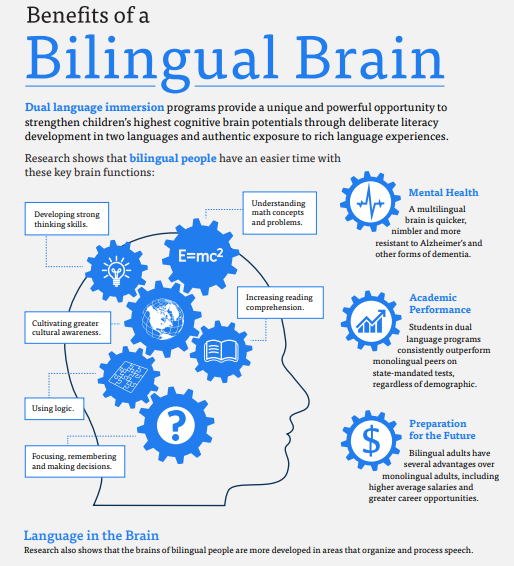Exploring the bilingual brain
Nafisa Ishra. 03/26/2021

There are many people all over the world who can speak more than one language, either out of necessity or simply by choice. Being bilingual can offer so much more than simply the ability to communicate with more people. For example, it can improve brain function and slow down the effects of aging.
How does being bilingual affect brain structure?
Being bilingual can improve one’s executive function, which is one’s ability to plan, coordinate attention and avoid distractions. This is because the area of the brain that is used to regulate two languages is also used when performing tasks while filtering out distractions. In general, the bilingual brain has greater gray matter (the cell bodies and dendrites in our neurons). Gray matter is connected to memory, decision-making, speech, etc., making gray matter associated with the health of the brain. Additionally, the bilingual brain has stronger neural connections, and its white matter (the axons of the neurons) suffers less damage, which means the communication between neurons is quicker.
Professor Viorica Marian from Northwestern University conducted a study that revealed that more areas of the brain, specifically the frontal and subcortical areas, were affected in a bilingual person than a monolingual person when they heard similar sounding things. A monolingual brain tends to only think of words in that language while bilinguals have to use more parts of the brain to differentiate between similar sounding words from two different languages. This points to greater neural plasticity, which is the ability of our nervous system to adjust to environmental changes.
The bilingual brain also experiences the effects of aging at a slower rate. For one, degradation of white matter is associated with aging, and as stated above, the white matter in a bilingual brain experiences less damage. Being able to coordinate attention to different tasks while avoiding distractions also gives bilinguals an advantage because the inability to control attention is connected to the loss of cognitive function as we age.
How does being bilingual affect children?
There are some common misconceptions when it comes to being bilingual that need to be addressed. First, if a child learns two languages together, it will not confuse them or hinder their development. In fact, cognitive flexibility (the ability to switch between different tasks or ideas) in a child’s brain will increase because their cognitive muscles need to work hard to switch from one language to another. Children frequently do this when speaking to different family members, and this can later be applied to other everyday tasks. The results of a 2004 study conducted by psychologists Ellen Bialystok and Michelle Martin-Rhee highlight that bilingual children could separate objects based on their shape and color more easily than monolingual children which points to a higher functioning command center in the brain of bilingual children. The command center of the brain controls problem-solving and execution of difficult cognitive tasks.
Additionally, another widely held belief is that children learn a second language faster than adults, but whether or not that is true is still an ongoing debate. Children can pick up the basics of a language faster than adults because their brains can create neural connections at a much higher rate. As a result, they have greater brain plasticity. Another area that children excel at is pronunciation because they have greater neuromuscular control, as their brains are not used to any phonetics yet, making it easier for them to create new sounds. However, when it comes to mastery of a second language, adults are still superior because children are unable to comprehend things such as verb tenses and sentence structure while the adults are bound to focus on those skills when they actively study a second language. Children will pick up vocabulary from their family members without even realizing they are learning something, making their language skills more elementary.
Many scientists use the Critical Period hypothesis, by Wilder Penfield and Lamar Roberts, to argue that learning a second language is faster for children. The hypothesis states that there is a critical period of time, which ends when a person reaches puberty, for language learning, but this is only true for a first language. Many studies have shown that the critical period differs based on the category of language learning such as phonology or syntax, and there is no sudden change in our ability to learn a second language right after puberty.
There are still so many questions unanswered about the bilingual brain. What other differences are there between a bilingual brain and a monolingual brain that we have yet to discover? Why do the same rules not apply to learning a first and second language for children? Despite all of these mysteries that remain unsolved, there are several benefits to learning a second language that have already been proven for both adults and children. So even if it might seem unfathomable with most of our busy schedules, try setting aside 10 minutes a day, open up Duolingo, start learning some basic vocabulary and go from there.
Cover Photo: (Bhlingual)
